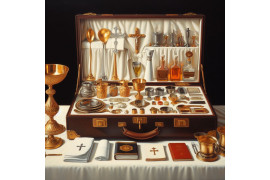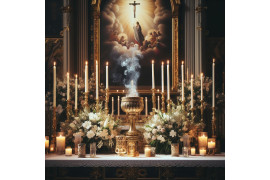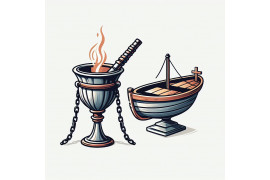Monstrances have been an integral part of Catholic worship for centuries, specifically in relation to the holy Eucharist and holy communion. They are used to display the consecrated host during the act of perpetual adoration, where it is placed inside the tabernacle. These exquisite vessels, known as ciborium, often crafted with intricate designs and made from precious materials, hold great significance in the Catholic faith as they are used to hold the holy Eucharist, also known as the blessed sacrament. They are also sometimes used to store relics. Serving as a focal point during Eucharistic adoration, the tabernacle containing the consecrated hosts symbolizes the utmost reverence for the presence of Christ in the blessed sacrament. Monstrances and ciborium are also used for this purpose.
The use of monstrances in displaying the consecrated host for public veneration can be traced back to medieval times. Monstrances are used during private adoration of the blessed sacrament in the tabernacle, creating a holy experience. The ornate nature of these sacred vessels, which hold the consecrated hosts, reflects the importance placed on the Eucharist as the central sacrament of Catholic belief. These vessels are kept in the tabernacle by the holy priest.
In this blog post, we will explore the tabernacle, a sacred container used by priests to store consecrated hosts. We will delve into their intricate designs, examine their role in religious ceremonies, and discuss their symbolism within the context of Catholic theology. Additionally, we will touch upon the significance of the pope in relation to the tabernacle and its contents.
Role of Monstrance in Religious Ceremonies and Worship
Monstrances play a significant role in Catholic religious ceremonies and worship, especially during the veneration of the blessed sacrament in the tabernacle. The priest, or even the pope, may use the monstrance to display the blessed sacrament for adoration by the faithful. These holy vessels, containing the blessed sacrament, are prominently displayed during Eucharistic processions, serving as a focal point for adoration and reverence. They hold the consecrated bread in the tabernacle. Let's explore the importance of monstrances in enhancing the spiritual atmosphere during Mass, particularly when it comes to the blessed sacrament and the sacred host. The presence of the tabernacle and the hour of adoration play a significant role in creating a reverent and holy environment.
Prominent Display During Eucharistic Processions
During Eucharistic processions, the blessed sacrament, in the form of bread, is carried through the church or chapel and placed in the tabernacle for all to see and venerate. This sacred hour allows worshipers to connect with the divine presence. The tabernacle, often elaborately designed with precious metals and adorned with jewels, holds the blessed sacrament, which is the consecrated bread, at its center. The monstrance is used to display the blessed sacrament for adoration and prayer throughout the day and night, ensuring that it is always available for worshipers to spend an hour in quiet contemplation. This visually captivating display of the tabernacle and blessed sacrament allows believers to connect with the presence of Christ in a tangible way. The sacred host, or bread, is prominently featured in this display.
Focal Point for Adoration and Reverence
The presence of a blessed sacrament in a monstrance during Mass creates an atmosphere of deep reverence and adoration for the hour of consecration and the breaking of bread. As worshipers gaze upon the exposed blessed sacrament, the bread within the monstrance, they are reminded of Christ's sacrifice on the cross and his real presence in the Eucharist. This visual representation serves as a powerful reminder of their faith and encourages them to deepen their devotion to the blessed sacrament, which is represented by the bread.
Visual Connection with the Consecrated Host
Monstrances provide believers with a unique opportunity to visually connect with the blessed sacrament, specifically the consecrated bread. By displaying the blessed sacrament within this sacred vessel, worshipers can witness firsthand the physical manifestation of their Lord and Savior in the form of bread. This visual connection strengthens their belief in Christ's true presence in the Eucharist, fostering a deeper spiritual connection with bread.
Enhancing Spiritual Atmosphere During Worship
The presence of a monstrance significantly enhances the spiritual atmosphere during Mass, especially when it is adorned with beautiful bread. As worshipers gather around the bread, there is a sense of unity and reverence that permeates throughout the congregation. The sight of the exposed bread within this ornate vessel inspires awe and wonder, creating an environment conducive to prayer, reflection, and worship.
Exploring the Eastern and Western Traditions of Monstrance
In Western Christianity, monstrances are known for their ornate and elaborate designs, often featuring intricate patterns and motifs. These sacred vessels are used to display the consecrated bread during religious ceremonies and are considered highly significant in the faith. These sacred vessels are used to display the Eucharist bread for veneration during religious ceremonies. However, in Eastern Christian traditions, a simpler form of monstrance is used, known as a bread diskos or paten.
Both the Eastern and Western traditions place great emphasis on the sacredness of displaying the Eucharist, which is often symbolized by the presence of bread. In Western Christianity, monstrances are often made of gilded metal and adorned with intricate details, showcasing the sacred bread. They feature a lunette at the top, which holds the consecrated bread for worshipers to see and adore.
On the other hand, in Eastern Christian traditions, diskos or patens serve a similar purpose but have a more modest design compared to their Western counterparts. These Eastern Christian traditions often involve the use of bread. These metal vessels, often used for displaying bread, typically do not have the intricate decorations commonly seen in Western monstrances.
The design and style of monstrances, used to display the consecrated bread, can vary across different regions and cultures within both Eastern and Western Christianity. In some cases, they may be influenced by local customs or artistic trends. For example, in certain parts of Europe, monstrances may be crafted using gold or silver filigree work.
Regardless of their specific design elements, both types of monstrances serve as focal points during religious services, where believers can direct their prayers and adoration towards the Eucharist. The presence of these sacred vessels on the altar enhances the spiritual experience for worshipers.
It's important to note that while monstrances play a significant role in Catholic worship practices, not all Christian denominations use them in their religious services. Some Protestant churches do not incorporate this particular practice into their worship rituals.
The Elements and Purpose of a Monstrance
A monstrance is a sacred vessel used in the Catholic Church to hold and display the consecrated host for adoration by believers. It consists of several elements that come together to create a visually striking and reverent object.
A typical monstrance consists of a base, stem, luna (receptacle), and rays or ostensorium (display area).
The base serves as the foundation of the monstrance, providing stability and support. It is often made of metal, such as gold or silver, and may be adorned with intricate designs or symbols. The stem rises from the base, connecting it to the luna.
The luna is a special receptacle that holds the consecrated host—the bread that has been transformed into the body of Christ during Mass. It is usually circular and made of glass or crystal, allowing worshipers to see the host within. The luna is securely placed within the rays or ostensorium.
The rays or ostensorium from the display area of the monstrance. They radiate outward from the center where the luna is placed, resembling beams of light shining forth. This design element symbolizes Christ's presence illuminating the world. The rays are often intricately decorated with gems, engravings, or filigree work, adding to their visual appeal.
The purpose is to hold and display the consecrated host for adoration by believers.
The primary purpose of a monstrance is to provide a vessel for displaying and honoring the consecrated host during Eucharistic adoration. This practice involves believers spending time in prayerful contemplation before Jesus present in the Eucharist.
By placing the consecrated host within a monstrance and elevating it for all to see, it allows worshipers to focus their attention on Christ's real presence in this sacred sacrament. It serves as a tangible reminder of the central mystery of the Catholic faith—the belief in the true presence of Jesus in the Eucharist.
Many monstrances feature intricate decorations such as gems, engravings, or filigree work.
The design elements of a monstrance are not merely ornamental but serve a purpose. The use of precious materials and intricate craftsmanship reflects the reverence and adoration that believers have for the Eucharist. The beauty and splendor of these decorations aim to enhance the visual impact and draw worshipers into a deeper sense of awe and reverence.
The addition of gems, such as diamonds or rubies, can symbolize Christ's divine majesty and kingship. Engravings may depict religious symbols or scenes from Scripture, further deepening the connection between the Eucharist and the larger story of salvation. Filigree work, delicate patterns made from fine wires, adds an exquisite touch to the overall design.
Eucharistic Adoration and Monstrance in the Catholic Church
Eucharistic adoration is a deeply spiritual practice within the Catholic Church that involves revering Christ's presence in the consecrated host outside of Mass. During this time, believers have the opportunity to pray, meditate, or simply spend quiet moments in contemplation before the exposed host. This practice is facilitated by a sacred vessel called a monstrance, which provides a visible representation of the Eucharist.
Revering Christ's Presence
Eucharistic adoration allows Catholics to express their devotion and reverence for the Holy Eucharist. It is an opportunity for believers to connect with Christ on a personal level and deepen their faith. By spending time in prayer and contemplation before the exposed host, Catholics believe they are communing with Jesus himself.
The Role of a Monstrance
A monstrance is an ornate vessel used during Eucharistic adoration to display and honor the consecrated host. It typically consists of a stand or base, a stem, and rays that hold the sacred host in place. The design often incorporates precious metals such as gold or silver and may be adorned with gemstones or intricate detailing.
The purpose of a monstrance is to provide a focal point for adorers during Eucharistic adoration. By placing the consecrated host within the monstrance, it becomes more visible to those present, allowing them to direct their prayers and devotion towards it.
Symbolic Representation
The use of a monstrance serves as a symbolic reminder of Christ's presence in the Eucharist. Just as light radiates from its rays, believers see this vessel as illuminating their spiritual journey and drawing them closer to God. The beauty and craftsmanship displayed in each monstrance also reflect the importance placed on honoring Christ's body through artistry.
A Sacred Practice
Eucharistic adoration holds significant meaning for Catholics, as it allows them to express their love and devotion towards the Eucharist. It is often practiced in dedicated spaces such as adoration chapels or within a church's sanctuary. Some churches even offer perpetual adoration, where the Eucharist is continuously exposed for private adoration throughout the day and night.
Monstrance in Eastern Catholic Churches and Eastern Orthodox Churches
In Eastern Catholic Churches, the use of monstrances may vary depending on specific traditions and customs. While the Western Catholic Church places great emphasis on the elaborate display of the Eucharist using a monstrance, Eastern Catholic Churches have their own unique practices.
Some Eastern Orthodox Churches do not typically use monstrances, but instead utilize other vessels for displaying the Eucharist. These vessels may include a diskos or paten, which are flat plates used to hold the bread during the Divine Liturgy. The emphasis in these traditions is on reverence rather than elaborate display.
Despite these differences, both Eastern Catholic and Orthodox churches hold the Eucharist as sacred. They believe that during the consecration by priests, bread and wine become transformed into the body and blood of Christ. This belief is central to their faith and is celebrated with great reverence.
In some Eastern Catholic traditions, a special cloth called an Aer is used to cover the chalice containing the Eucharist during processions or when it is displayed for adoration. The Aer symbolizes Christ's burial shroud and serves as a reminder of His sacrifice.
While Western Catholics often use elaborate monstrances made from precious metals adorned with jewels, Eastern Catholics may opt for simpler designs that focus more on functionality rather than ornate decoration. Many monstrances in Eastern tradition are made from materials such as wood or brass.
The primary purpose of using a monstrance or any vessel to display the Eucharist is to facilitate adoration and reverence towards this sacred sacrament. It allows believers to visually witness and honor Christ's presence in the consecrated host.
In addition to its practical function, using a vessel like a monstrance also serves as a visual representation of Christ's presence among his followers. By displaying the Eucharist prominently within a church or during processions, it becomes a focal point for worshipers' devotion.
Embracing the Sacredness of Monstrance
We delved into both Eastern and Western traditions surrounding this sacred vessel, examining its elements, purpose, and its central role in Eucharistic adoration within the Catholic Church. We also discussed how monstrances are utilized in Eastern Catholic Churches and Eastern Orthodox Churches.
By understanding the history and cultural importance of monstrances, individuals can gain a deeper appreciation for their role in religious practices. Whether you are a member of the Catholic faith or simply intrigued by religious artifacts, embracing the sacredness of monstrance allows for a greater understanding of spirituality.
To continue your exploration into sacred vessels like monstrances, consider visiting local churches or museums that exhibit religious artifacts. Engaging with experts in theology or art history can provide further insights into their cultural significance. By immersing yourself in these experiences, you will deepen your knowledge and appreciation for the rich traditions associated with sacred vessels.
FAQs
What materials are used to make a traditional monstrance?
Traditional monstrances are often made from precious metals such as gold or silver. These materials symbolize the reverence placed on the Eucharist and highlight its importance within religious ceremonies.
Can anyone participate in Eucharistic adoration?
Eucharistic adoration is open to all individuals who wish to spend time in prayerful contemplation before the Blessed Sacrament. It is not limited to members of specific religious denominations, but is rather an opportunity for personal reflection and spiritual connection.
Are there different styles of monstrances?
Yes, there are various styles of monstrances influenced by different artistic periods and cultural traditions. Some may feature intricate designs adorned with gemstones or filigree work, while others may adopt simpler forms that prioritize functionality over elaborate embellishments.
How long has Eucharistic adoration been practiced?
The practice of Eucharistic adoration dates back centuries and has been an integral part of Catholic worship since the Middle Ages. It continues to be observed in churches worldwide as a means of expressing devotion to the presence of Christ in the Eucharist.
Are monstrances used in other religious traditions?
While monstrances are primarily associated with the Catholic Church, similar vessels are also utilized in some Eastern Orthodox Churches and Eastern Catholic Churches. However, their specific forms and practices may vary within these traditions.



